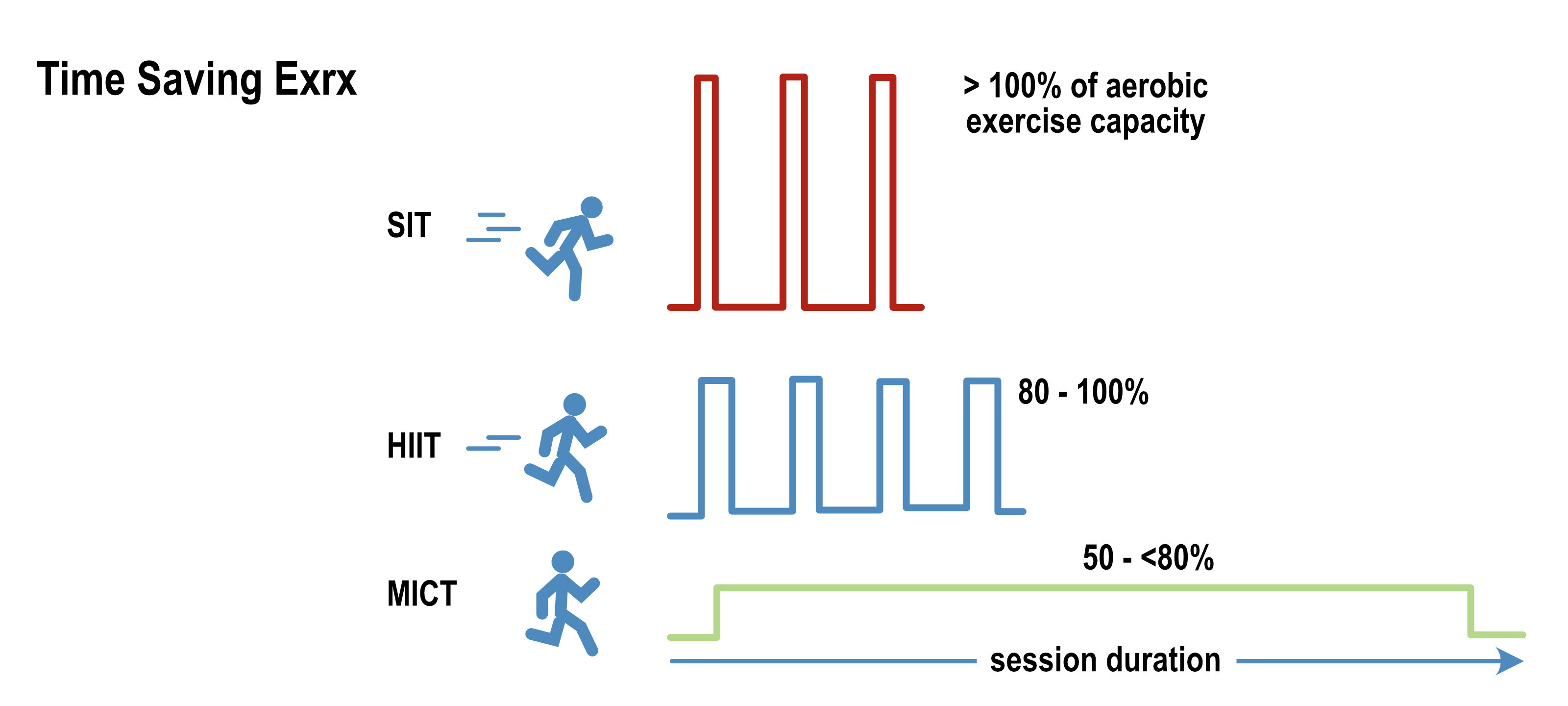What is new?
Recent research demonstrates that novel exercise routines yield the same or even better effects than longer-duration traditional routines
Why it matters
Lack of time is the largest obstacle for most people to commit to regular exercise routines. Knowledge about how to dramatically cut time commitments may enable many to realize the health and longevity benefits of exercise.
Introduction
Wouldn’t it be nice if we could do to exercise what data compression does to video files? That means losing all the redundant and irrelevant things that make raw video files so large and exercise so time-consuming.
After all, physical fitness, the consequence of sufficient exercise, is THE most important predictor and driver of health- and lifespan. Since lack of time is the most often cited obstacle to exercise, we are going to take a deep dive into the “compression options” you have. With a particular focus on cardiovascular health, because cardiovascular disease (CVD) is the number one cause of disability, dementia, and death.
Nobody doubts the beneficial effects of conventional exercise training on fitness and health. Be that aerobic or resistance training. Equally well established is the fact that conventional training routines can be made far more time-efficient [1]. The better-known varieties of time-efficient training are the aerobic high-intensity interval (A-HIIT) and sprint interval (SIT) training routines. Less well-known are resistance HIIT (R-HIIT), isometric strength training, and inspiratory muscle strength training (IMST).
Let’s start with the latest insights on the better-known ones.
HIIT and SIT
In HIIT high-intensity intervals (typically 30–60 seconds) alternate with recovery intervals (1–2 minutes). While there is no uniform definition of HIIT, “high intensity” means exercising between 85% and 100% of your maximum load.
In SIT, you’ll go above the 100% maximum but for shorter periods (15–20 seconds). I have detailed the HIIT and SIT routines in a previous post.
Here is what it looks like:

HIIT and SIT can improve cardiovascular function in midlife and older adults with time commitments of 30 minutes per week or even less [1]. Research also suggests that these improvements are not only comparable but even superior to traditional moderate-intensity continuous aerobic exercise training (MICT) [2].
Compare 30 minutes per week with what the WHO suggests:
- “do at least 150–300 minutes of moderate-intensity aerobic physical activity;
- or at least 75–150 minutes of vigorous-intensity aerobic physical activity; “
Now you know what I mean by “compression”. Quite obviously, there is redundancy and irrelevant components. But get that into the brains and guidelines of health bureaucrats (who are often the very hallmarks of redundancy and irrelevancy).
Inspiratory muscle strength training (IMST)
IMST is “weightlifting” for your inspiratory muscles—the diaphragm and the intercostal muscles that run between your ribs. If you breathe in against some resistance, these muscles have to work harder. And, as you know, working harder than usual triggers an adaptive response in every muscle, be that your biceps, your heart, or your diaphragm.
That’s the obvious part. What’s not so obvious is that high-resistance IMST inspiratory muscle strength training lowers blood pressure, reduces blood markers of inflammation, and improves endothelial function as measured by flow-mediated dilation (FMD) [3].
The researchers tested a routine of IMST that requires only 30 breaths (≈5 minutes) per session using an affordable and portable handheld device (POWERbreathe).
Just so that you don’t get the wrong impression: I am not advertising their product, I have no relation with that company, and I don’t receive any money from them. I am simply reporting to you the methods and instruments that the researchers used.
A caveat about IMST: the cited experiment did not improve pulse wave velocity (PWV), a marker of arterial stiffness. However, the nearly 10 mmHg blood pressure reduction (systolic) was quite impressive.
While IMST will not affect the strength and endurance of muscles that you train with physical exercise, it reduces biomarkers of risk (e.g., blood pressure and FMD) at a minimal time commitment of 5 minutes per day.
Resistance HIIT
A very recently published study compared the acute effects of the HIIT routine applied to resistance training (R-HIIT) vs. aerobic HIIT (A-HIIT). Subjects performed both training modes at the same duration and intensity.
So, what did the R-HIIT look like? Subjects had to perform 10 60-second working intervals, each separated by 60-second recovery periods. During the working intervals, participants performed barbell back squats with a load of 20% of their body weight. That is, they carried a barbell on their shoulders while doing the standing squats at a maximum cadence of 30 reps per 60-second working interval. R-HIIT reduced blood pressure and vascular stiffness to a greater extent than A-HIIT. That was a surprise finding.
A caveat: researchers monitored the effects of this training routine only immediately and 30 minutes post-exercise. So, we don’t really know whether and how this will translate into more permanent effects when people adopt such routines, say three times a week.
I am quite optimistic, though, because we see such acute effects in other types of more time-consuming exercise that then show up on longer-term follow-up.
Isometric training
Again, a very recent review [4] came to the surprising conclusion that isometric wall squats (IWS) outperformed all other exercises in lowering blood pressure, except for aerobic training which was on par with IWS [4].
A wall squat involves going into a squat position at 90-degree knee flexion with your back leaning against a wall. Holding this position for any length of time, ideally until you feel the burn. Typical protocols employ 4×2 min contractions, separated by 1–4 min rest intervals, performed three times a week.
Again, the overall net effect across studies on blood pressure was an impressive 10 mmHg reduction (systolic).
Summary
The research findings demonstrate that “exercise compression” is real and possible. Quite substantially so. That offers time-starved individuals a unique opportunity to expand their health and life expectancy.
It shows that not only is a little exercise better than none, but it can be on par with more exercise.
Let’s hope that this compression becomes a more widely accepted standard, much as its video equivalent became the standard for the pastime that preoccupies most people’s leisure time.
Cited References
[1] Craighead DH, Heinbockel TC, Hamilton MN, Bailey EF, MacDonald MJ, Gibala MJ, et al. Time-efficient physical training for enhancing cardiovascular function in midlife and older adults: Promise and current research gaps. J Appl Physiol 2019;127:1427–40. doi:10.1152/japplphysiol.00381.2019.
[2] Hasegawa N, Fujie S, Horii N, Miyamoto-Mikami E, Tsuji K, Uchida M, et al. Effects of Different Exercise Modes on Arterial Stiffness and Nitric Oxide Synthesis. Med Sci Sports Exerc 2018;50:1177–85. doi:10.1249/MSS.0000000000001567.
[3] Craighead DH, Heinbockel TC, Freeberg KA, Rossman MJ, Jackman RA, Jankowski LR, et al. Time-Efficient Inspiratory Muscle Strength Training Lowers Blood Pressure and Improves Endothelial Function, NO Bioavailability, and Oxidative Stress in Midlife/Older Adults With Above-Normal Blood Pressure. J Am Heart Assoc 2021:e020980. doi:10.1161/JAHA.121.020980.
[4] Edwards JJ, Deenmamode AHP, Griffiths M, Arnold O, Cooper NJ, Wiles JD, et al. Exercise training and resting blood pressure: a large-scale pairwise and network meta-analysis of randomised controlled trials. Br J Sports Med 2023:bjsports-2022–106503. doi:10.1136/bjsports-2022–106503.


0 Comments